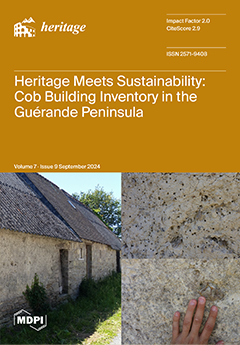External and internal microclimatic conditions, biodeterioration, anthropogenic factors, etc, influence the natural stone support for artifacts and built heritage. Based on this fact, the present study explores the effectiveness of nano-TiO
2 in preserving and enhancing the durability of natural stone used in
[...] Read more.
External and internal microclimatic conditions, biodeterioration, anthropogenic factors, etc, influence the natural stone support for artifacts and built heritage. Based on this fact, the present study explores the effectiveness of nano-TiO
2 in preserving and enhancing the durability of natural stone used in the façades of heritage buildings, focusing on the Markovits-Mathéser House in Oradea Municipality, Romania. The investigation involved treating rock samples (fossiliferous limestone) with 2% and 5% nano-TiO
2 solutions and subjecting them to simulated extreme climatic conditions for the analyzed area in a controlled climatic chamber for six months. The treated samples demonstrated a significantly higher compressive strength than untreated benchmarks. SEM analyses confirmed that nano-TiO
2 formed a protective layer, filling micro-cracks and pores, thereby enhancing the stone’s resistance to environmental stressors. The study also found that the nanoparticle coating maintained its integrity under extreme temperature and humidity variations, with only a slight decrease in surface coverage. These findings suggest that nano-TiO
2 coatings significantly improve heritage building materials’ mechanical properties and longevity. However, the study highlights the importance of careful application and long-term evaluation to ensure environmental and health safety. Overall, nano-TiO
2 presents a promising solution for the conservation of cultural heritage, offering enhanced durability and protection against climatic and environmental challenges. Further research is recommended to optimize application workflow and formulations for broader and more effective use in heritage conservation.
Full article





